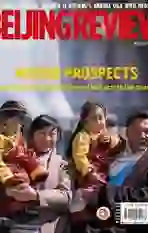Facing up to Poverty Reduction Challenges
2017-04-13
China will lift 10 million rural residents out of poverty in 2017, according to the Government Work Report delivered by Premier Li Keqiang on March 5. Li also highlighted specifi c poverty alleviation measures listed in the report, such as improving infrastructure and public services in poor areas and promoting the development of specialty industries in order to improve the self-development capacities of impoverished people.
In 2016, 12.4 million people were brought above the poverty line, beating the governments target of 10 million people for that year. Realizing this years target seems rational.
Eliminating poverty is a primary component of the objective of completing the building of a moderately prosperous society in all respects by 2020. Every local government has set its own specifi c goals related to the task. Over the past year, poverty reduction has achieved tangible results in various localities, with the number of impoverished people having been reduced significantly. Tibet Autonomous Region is one of the areas to have made remarkable progress in this regard. Last year, 130,000 people in the region were lifted out of poverty.
The state attaches great importance to poverty alleviation efforts in Tibet. Central government allocations have con- stituted the major source of funding for Tibets poverty reduction plans.
The Tibet Regional Government has invested heavily in developing competitive industries, tourism in particular, to increase peoples incomes. Local administrations also register all of their areas impoverished residents and allocate staff to help, guide and support these people to escape poverty. Moreover, the region has launched a program to relocate people living in impoverished areas with inhospitable environmental conditions.
At the end of 2016, Chinas impoverished population numbered 43.35 million, mostly distributed in rural areas. Also, the poverty that remains today despite the many previous campaigns tackling the issue, is a hard nut to crack, which requires greater efforts to be made.
Targeted measures ensure thorough poverty alleviation. The government should help the poor to secure employment by creating jobs, providing training opportunities and employment services, and protecting their rights at work.
Given the achievements of Tibet and other regions in addressing poverty, it is reasonable to believe that Chinas goal of ridding its society of poverty will be realized by 2020, which will make China the first developing country to accomplish the task.
